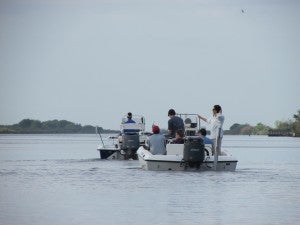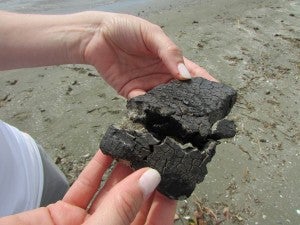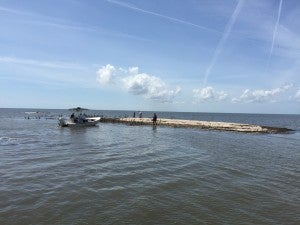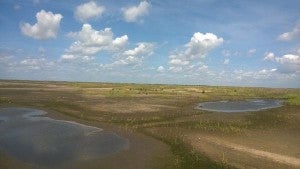Five years after oil spill, boat trips to Barataria Bay reveal tar balls, dying islands
Sadly, this is not an April Fools joke.
Nearly five years after the BP Gulf oil disaster, we took a trip to Louisiana’s Barataria Bay to see the continuing and ongoing environmental effects of the spill. Representatives from Environmental Defense Fund, National Wildlife Federation, National Audubon Society, Louisiana Wildlife Federation and Restore or Retreat organized a boat tour for local and national media to see for themselves the continued negative effects of the spill and the dire need for restoration.

David Muth with the National Wildlife Federation gives an overview of the tour at the Myrtle Grove Marina.
Launching off from the Myrtle Grove Marina 25 miles south of New Orleans, our flotilla traveled south into Barataria Bay, which was one of the most heavily oiled areas during the spill. Five years later, the effects of the oil disaster are still visible.
The first stop of our tour was East Grand Terre Island, where just two weeks ago, crews uncovered a 25,000-pound BP tar mat on the island. Yesterday, five years after the oil spill, we still found tar mats and tar balls on East Grand Terre.
Next, we traveled to Cat Island, a mangrove island in Barataria Bay that was heavily oiled during the spill. Once a lush, thriving bird rookery, teeming with pelicans, rosette spoonbills, least terns and others, the island is now a skeleton of its former self: small, gray and lifeless. The mangroves that once dominated the island are sensitive to oil, which in turn killed the mangroves and caused the island to erode and slowly vanish. Observers noted that this may be the last year that we see Cat Island, as it may be completely gone by this time next year.
The final stop on our tour was the Lake Hermitage Marsh Creation project, which is some of the newest land in Louisiana. This project uses sand dredged from the Mississippi River to build marsh. It’s being funded through the Coastal Wetland Planning, Protection and Restoration Act (CWPPRA) and the early Natural Resource Damage Assessment funding. This project has restored 650 acres at the cost of $50 million.
Despite what BP claims, we saw evidence showing that the oil spill is not over and its effects are ongoing. Tar mats and tar balls are still washing ashore, and islands and marsh are still in need of repair and restoration. Five years later, BP needs to accept responsibility and “make it right” for the communities, environment and wildlife of the Gulf Coast.
- Learn more about the ongoing effects of the oil disaster in our 5 years later oil spill infographic.
- Read this statement about the ongoing effects of the spill and the need to hold BP accountable.
- Take action to ensure vital restoration happens soon.



